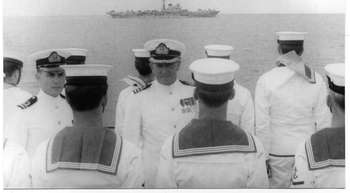- Author
- Fogarty, Michael
- Subjects
- Biographies and personal histories, Obituaries
- Tags
-
- RAN Ships
- HMAS Duchess
- Publication
- March 2010 edition of the Naval Historical Review (all rights reserved)
The commanding officer attempted to light his cigarette. He had gathered his officers in the wardroom to brief them on a dramatic change to the ship’s 1967 program. HMAS Duchess was then serving with the British Fleet in the Far East Strategic Reserve. This former Royal Navy destroyer, which replaced the sunken HMAS Voyager in 1964, was the little ship that could – given half the chance. While its crew were willing, the poor state of the hull and its machinery spaces informed the private despair of the operational and technical staff at Fleet headquarters. She retired hurt.
The ship’s captain regarded his officers with a grim fixity of purpose, as he attempted to achieve ignition. He failed spectacularly and its end soon flared. Transfixed by this new stunt, no one spoke. Until the gunner, ‘Squizzy’ Taylor, came to his rescue. ‘Wrong end, sir!’ After a paroxysm of coughing, a red-faced senior officer recovered and adjured his young officers. ‘Let that be a lesson to you, of the evils of smoking filter-tipped cigarettes’. Unlike the USS Caine, Duchess did not need a Morale Officer. His fine leadership ensured that morale would never flag.

Commander Hugh Kelvin Duncan, OAM, RAN, (Retired) who died on 30 November aged 86, was the first former sailor in the Royal Australian Navy to command a fleet destroyer. He was a member of the vanishing present, among the dwindling numbers of that great generation, those Australians who made it so in World War II. His was a life of two halves. Not content to bask in his achievements, he soon turned strong reserves of random energy into community service. His record was embarrassing, for he was a one-man NGO, filling vacuums and making things happen.
Kelvin was born on 11 February 1923 at Henty, NSW where he worked in the family store as a grocer’s assistant. At the war’s start, he was taken by an RN poster which featured many HM ships – including Hugh (Walpole), Kelvin and Duncan. Not to be outdone, he later married the ‘Lady’ Lillian. He told his father: ‘That’s it, Dad. I am destined to join the navy’. This he did, in 1940, as an ordinary seaman second class at HMAS Cerberus. Many of his recruit intake were killed next year when HMAS Sydney was lost with all hands off the coast of Western Australia.
Young Duncan fought a just war off New Guinea, Burma, the Philippines and Okinawa. He was in HMAS Nepal at the Japanese surrender in 1945. By then, he was an acting petty officer in the torpedo category. While hostilities had ended, a more incipient threat emerged in its aftermath. In peacetime, all services had to deploy an explosive ordnance demolition front against the detritus of war – enemy and allied. Then an instructor, he joined parties to dispose of recovered munitions. He was commended for his arduous service in those hazardous mine counter-measure operations.
Promoted in 1952, to commissioned gunner torpedo anti-submarine (TAS), Kel spent a long attachment with the Royal Navy, including service in HMS Sheffield with NATO forces. In 1955, having returned home as a lieutenant, his career bloomed, but not without some good mentors. He did two tours during the Malayan Emergency in Q class ships, interspersed by a key posting heading the seamanship school at Cerberus. He made Lieutenant-Commander in 1961 and was appointed as an acting Commander, when he briefly commanded HMAS Huon, in Tasmania.
For his expertise, Kel later commanded HMA Ships Rushcutter and Waterhen, with a return as training commander at Cerberus in between. In 1965, Kel served as the Executive Officer of the fleet oiler, HMAS Supply, and in early 1966, he was appointed to drive Duchess. The appointment attracted both praise and interest. Clearly, he would come under more scrutiny than those among the officer corps who had achieved command through their own professional service college path. He made the grade and he got his ship together. Confirmed in his last rank, he was fit for sea command.




